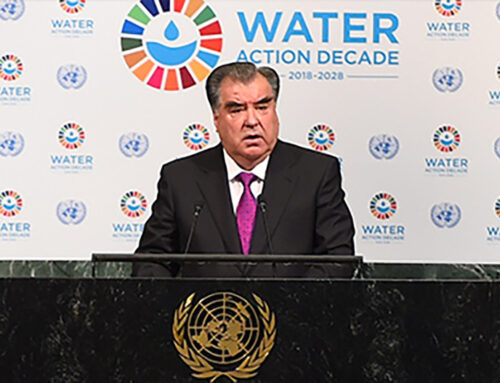
Water is essential to all human and other life-forms. A shortage of water can have devastating consequences, causing a sharp fall in food- production and threatening life itself. Water shortages can lead to huge movements of people and can even be the root cause of conflict. But to find water disputes in a land of plenty is both bizarre and unusual and yet this is the situation in Central Asia today.
During Soviet times, everything was planned centrally by Moscow. In his on-going war to ‘tame’ nature, Stalin ordered great reservoirs to be constructed in the mountainous territories of Tajikistan and Kyrgyzstan to supply water for agricultural irrigation in the downstream countries during the hot summer months. In return, some of the rich coal and oil reserves of the downstream republics were sent to Tajikistan and Kyrgyzstan to provide them with energy in the freezing snows of winter.
During the Soviet era, Moscow put pressure on Kyrgyzstan and Tajikistan to empty their reservoirs during the summer months so that the cotton fields in downstream states could be irrigated. All of this changed after independence. Kyrgyzstan and Tajikistan now store water during the summer and release it during the winter to generate hydroelectric power. This has led to a number of serious disputes since independence. As a direct response of these problems, the downstream nations like Uzbekistan began the feverish construction of reservoirs, intent of maintaining their own summer water supplies, using the water for irrigating great swathes of cotton and even rice. This activity contributed to the worsening desiccation of the Aral Sea.
The greatest tensions currently exist between Tajikistan and Uzbekistan. The most recent manifestation of this tension has been the publication of a pseudo-academic article titled “Hydro-manipulations, or Water resources as a pressure leverage” in the Uzbek government newspaper “The Word of the People” on 25th of January 2013 in which the authors openly criticise the construction of the massive Rogun hydro electric scheme in Tajikistan, claiming that it will endanger life in the event of an earthquake and that it will deny essential water resources to Uzbekistan.
“The Word of the People” article makes no mention of Uzbekistan’s abysmal record on water conservation. Water is wasted on a gigantic scale in the rice and cotton sectors. Uzbekistan is the world’s third largest cotton exporter and earns around US $1 billion annually from the trade. Cotton production in Uzbekistan remains one of the most exploitative enterprises in the world; the Government routinely compels hundreds of thousands of children to work as labourers in the country’s annual harvest. Cotton is also a thirsty crop, requiring vast quantities of water for irrigation. The Uzbeks have built dozens of new canals, irrigation channels and reservoirs, most of which are earth-lined and prone to catastrophic water losses through seepage and evaporation.

Salinisation in the Aral Sea Basin and particularly in Uzbekistan is commonplace and has occurred both in water and on land as a result of the poor water management techniques used in the region. Excessive irrigation in the basin has caused the mobilisation of deep salt reserves in the soil, raised the water table and waterlogged fields. The soil is now so saline that the once lucrative Uzbek cotton industry is struggling. It is therefore surprising to see the authors of the article in “The Word of the People” newspaper, accuse the Tajik authorities of risking, through the construction of the Rogun dam, “the hydrochemical composition and salinity of the river water that in turn will increase the volume of the salt accumulating in irrigated areas.”
This is simply untrue. The biggest contributor to salinisation is the poor system of water management and the on-going focus on growing water-dependent crops like rice and cotton in Uzbekistan. The Rogun project on the Vakhsh River, will not reduce the supply of water to downstream nations, nor will it cause further salinisation; nor, incidentally will it be prone to collapse in the event of a major earthquake. Critics of Rogun seem to forget that it will be located upstream from an existing massive hydro plant and reservoir built during the Soviet era at Nurek. The huge 300 metre high earth and clay dam embankment at Nurek has withstood countless earthquakes. Its vast reservoir has maintained a steady and reliable source of water to Tajikistan’s downstream neighbours. Rogun will be no different.
When operational, Rogun will produce 3,600 MW at peak capacity. Over 45 km of underground tunnels have already been completed during the Soviet era and are now being refurbished. It is intended to dam the Vakhsh River in the steep narrow valley in which Rogun is located with a towering – 335 metre high stone and clay embankment, similar to the successful Soviet design used at Nurek. The overhead lines and infrastructure needed to sell this electricity to neighbouring countries like Afghanistan and Pakistan are already being built. The new reservoirs being planned at Rogun will take ten years to complete before they are fully operational, but the Tajiks guarantee that they will continue to supply their downstream neighbours with the same amount of water that they enjoy now via the Amu Darya and Syr Darya rivers. They claim that their new system of dams will provide a properly managed water source which will benefit everyone. The Tajiks claim that they have never and will never restrict water flow to their downstream neighbours.
Once it is operational, Rogun will provide a source of green, environmentally friendly energy which is both cheap and plentiful and will meet the needs of Tajikistan while also providing essential energy for neighbouring countries like Afghanistan and Pakistan. It seems like a win-win situation in an area that is desperate for energy. Combined with a more strategic use of water in the downstream countries, with concrete-lined reservoirs and droplet irrigation, there is no reason why the abundant water resources of Central Asia cannot be distributed fairly and used in a way that enhances, rather than threatens the future of the Ferghana Valley.
The Rogun Dam deserves a clean bill of health. The West and the EU in particular, must show their support for this ambitious project for the sake of Tajikistan’s and Central Asia’s long-term stability. The alternatives – long term poverty and desperation for its long suffering people – are in no one’s interests.
STRUAN STEVENSON, MEP
Struan Stevenson is a Conservative Euro MP for Scotland. He is President of the Climate Change, Biodiversity and Sustainable Development Intergroup in the European Parliament and is the author of ‘STALIN’S LEGACY – The Soviet War on Nature.’ (ISBN 978-1-78027-090-6) www.birlinn.co.uk





